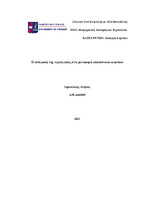| dc.contributor.advisor | Χονδροκούκης, Γρηγόριος | |
| dc.contributor.author | Δημουλάκης, Ανδρέας | |
| dc.date.accessioned | 2023-02-16T14:13:20Z | |
| dc.date.available | 2023-02-16T14:13:20Z | |
| dc.date.issued | 2023 | |
| dc.identifier.uri | https://dione.lib.unipi.gr/xmlui/handle/unipi/15135 | |
| dc.identifier.uri | http://dx.doi.org/10.26267/unipi_dione/2557 | |
| dc.description.abstract | Καθημερινά χρησιμοποιούμε χιλιάδες προϊόντα για να καλύψουμε τις ανάγκες μας.
Πολλά από αυτά ανήκουν στην κατηγορία των επικίνδυνων φορτίων (π.χ. καύσιμα,
απορρυπαντικά, αποσμητικά, αλκοολούχα ποτά κ.λπ.). Η μεταφορά τέτοιου είδους
φορτίων εγκυμονεί πολλούς κινδύνους τόσο για τον άνθρωπο όσο και για το περιβάλλον.
Σε αυτή την εργασία, παρουσιάζεται η έννοια των επικίνδυνων φορτίων, οι κατηγορίες
στις οποίες ταξινομούνται και οι κύριοι κανονισμοί, όπως η συμφωνία ADR, που
συνοδεύουν τη μεταφορά και αποθήκευσή τους. Στη συνέχεια, αναλύονται οι βασικές
προκλήσεις που προκύπτουν από τη μεταφορά αυτών των φορτίων, όσον αφορά στο
νομοθετικό πλαίσιο, τους διάφορους εμπλεκόμενους, τις εγκληματικές επιθέσεις καθώς
και κινδύνους που προκύπτουν από τη φύση των συγκεκριμένων υλικών. Επίσης,
αναφέρονται οι τεχνολογίες που χρησιμοποιούνται, όπως τα Συστήματα Υποστήριξης
Αποφάσεων (DSS), το Διαδίκτυο των Πραγμάτων (IoT), το Blockchain, τα Γεωγραφικά
Συστήματα Πληροφοριών (GIS) κ.λπ., για τη βελτίωση της αποτελεσματικότητας των
διαδικασιών, που απαιτούνται για τη μεταφορά επικίνδυνων φορτίων, τη μείωση των
κινδύνων και τη μείωση του χρόνου απόκρισης σε περίπτωση έκτακτης ανάγκης. Τέλος,
βλέπουμε παραδείγματα εφαρμογών των τεχνολογιών αυτών καθώς και τα
αποτελέσματά τους. | el |
| dc.format.extent | 79 | el |
| dc.language.iso | el | el |
| dc.publisher | Πανεπιστήμιο Πειραιώς | el |
| dc.title | Η επίδραση της τεχνολογίας στη μεταφορά επικίνδυνων φορτίων | el |
| dc.title.alternative | The impact of technology on the Transport of Dangerous Goods (TDG) | el |
| dc.type | Master Thesis | el |
| dc.contributor.department | Σχολή Ναυτιλίας και Βιομηχανίας. Tμήμα Βιομηχανικής Διοίκησης και Tεχνολογίας | el |
| dc.description.abstractEN | We daily use thousands of products to cover our needs. A wide variety of these products,
such as fuels, detergents, deodorants, alcoholic beverages and others, falls under the
category of dangerous goods. The transport of such products involves a great risk for both
human and the environment. This paper presents the notion of dangerous goods, the
categories in which they are classified and the main regulations, such as the European
Agreement concerning the International Carriage of Dangerous Goods by Road (ADR),
that accompany their transport and storage. Then, the main challenges that result from the
transport of such products, regarding the legislative framework, the different individuals
involved, the criminal aggressions and the risks arising from the nature of these specific
products, are analyzed. In addition, the technologies which are applied for the
improvement of the effectiveness of the processes required for the TDG, the reduction of
risks and the reduction of the response time in case of an emergency, are mentioned.
These technologies involve the Decision Support Systems (DSS), the Internet of Things
(IoT), the Blockchain, the Geographic Information Systems (GIS) and others. Finally, we
examine some examples of deployment of these technologies and their results. | el |
| dc.contributor.master | Βιομηχανική Διοίκηση και Τεχνολογία | el |
| dc.subject.keyword | Μεταφορά επικίνδυνων φορτίων (TDG) | el |
| dc.subject.keyword | ADR | el |
| dc.subject.keyword | Διαδίκτυο των Πραγμάτων (IoT) | el |
| dc.subject.keyword | Blockchain | el |
| dc.subject.keyword | Γεωγραφικά Συστήματα Πληροφοριών (GIS) | el |
| dc.subject.keyword | Συστήματα Υποστήριξης Αποφάσεων (DSS) | el |
| dc.date.defense | 2023-02-09 | |


